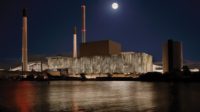For three centuries, Fortnum & Mason has purveyed fancy foodstuffs from premises on London’s Piccadilly, but, in recent years, England’s grandest grocery store has branched out, opening three satellite shops and restaurants, each designed by Universal Design Studio (UDS) with lighting by Speirs + Major. The latest is in the city’s financial district, where a gleaming Art Deco–inflected Fortnum & Mason bar and restaurant occupies a glass-roofed courtyard at the heart of the imposing Royal Exchange building (circa 1844), designed by Sir William Tite, now an upmarket mall. A Fortnum’s store has also been created within one of the glass-fronted units that line its perimeter.
Additional Content:
Jump to credits & specifications
While the neoclassical atrium makes a splendid backdrop, the yawning daylit space presented challenges. “It is a heavily trafficked thoroughfare,” says UDS director Hannah Carter Owers. “We wanted the bar to be visually arresting and to atmospherically occupy the space, but without obscuring diners’ views of the architecture.” Light plays a crucial role, commanding attention and conferring a distinct identity, while varying the ambience over time, with subtly different scenes for day, dusk, and night. “We needed to ensure that, even on a cold December morning, there would be warmth,” says Carter Owers, “and that the mood is also right for the end-of-work crowd.”
Banquettes enclose groups of loose tables at both ends of an island bar, a rounded rectangle that sits in the center of the space. Cool 3500 Kelvin (K) light from hidden undercounter fixtures lends a vivid glow to the bar’s cladding, hand-pressed ceramic tiles in Fortnums’ signature eau-de-nil color. A filigree canopy of shiny nickel-plated steel that projects over the bar was inspired by the company’s heritage, recalling both its classic silver tableware and tea tents supplied to Victorian travelers. Concealed uplights with a cooler color temperature of 4000K make the metalwork sparkle. The canopy’s interior surfaces have a brushed finish “which holds the light better, so the whole thing feels luminous,” says Speirs & Major principal Keith Bradshaw.
Bottle displays and the bar counter are bathed in a warmer 2700K light, which is more flattering to the diners, on whose faces it also falls. The figured-marble bar top appears to be lit by bespoke brass fixtures with tinted shades made by glassblower Michael Ruh, but these are discreetly supplemented by small mirror-polished luminaires in the canopy above. The whiskeys, standing on a stack of lightboxes, emit an amber glow. “For a bar to look great, you have to get some light into the liquid,” says Bradshaw. As the bar is both a working environment and a display space, the specification of every light source was informed by both functional and aesthetic requirements. Lighting within a glass refrigerator for smoked salmon, for example, was altered to a warm 2400K to bring out the pink tones of the fish.
Glittering like a cocktail cabinet, the bar is the convivial heart of the restaurant, but a different character was required for the dining areas, where individual table lamps cast small pools of warm light. Though the designers sought to replicate the intimacy of candlelight, the intensity of illumination can be adjusted by diners. “If people have to get their phones out to read the menu, we’ve failed,” says Bradshaw. Due to the difficulty of getting power to tables in the middle of the courtyard, the lamps run on rechargeable batteries.
Extensive preparatory testing and on-site adjustment were necessary to ensure that the quality of light was consistent across the disparate elements of the restaurant and the adjacent store, and to mitigate the natural lighting conditions in the existing space. Speirs + Major’s work began with “a huge amount of research into the quality of daylight—where it comes in, and when,” says Bradshaw. “Our job is to make natural and artificial light work well together.” This exercise shaped the lighting design scheme, but showed that the desired result could be achieved with three programmed “scenes” and did not require a more complex or dynamic control system.
To achieve the best results in dusk and nighttime settings, the designers persuaded the building’s owner that existing architectural lighting should be removed, so that the darkened stone facades would look “authentic—like an outdoor piazza,” says Bradshaw. Shopkeepers were also asked to moderate the illumination of their premises after closing time.
As one approaches the pedimented entrance to the Royal Exchange at dusk, the bar is clearly visible through glass doors, glowing like a beacon. With warm light twinkling on glass and brass under the shimmering tracery of steel, it exudes elegance and the promise of fun.
CreditsInterior Designer: Universal Design Studio
Consultants: Lighting Designer – Speirs + Major LLP Keith Bradshaw, Hiroto Toyoda, Jaime Fuentes McGreevy
Photographer: James Newton |
SpecificationsLighting Hospitality: STX 250: Mike Stoane Lighting Module Star: Mike Stoane Lighting Ultimo Side View: LedFlex UK Pigmy: Tala Ultimo TriView: LedFlex UK Flexi Panel: LedFlex UK LumenLine 120: LedFlex UK Victoria custom shade: Neoz Mezzanine: Blade LRi: ACDC l Retail Store: Supersystem II LED Spot Maxi: Zumtobel Supersystem II Low Voltage DALI track: Zumtobel Iris Star: Mike Stoane Lighting Atto Eye: Precision Lighting Air Mini LED 1000: ACDC Vector Flex: Lumino Lighting (supplied by Unibox) The Elizabeth: Bright Goods Controls: Dynalite: Architainment |






Post a comment to this article
Report Abusive Comment